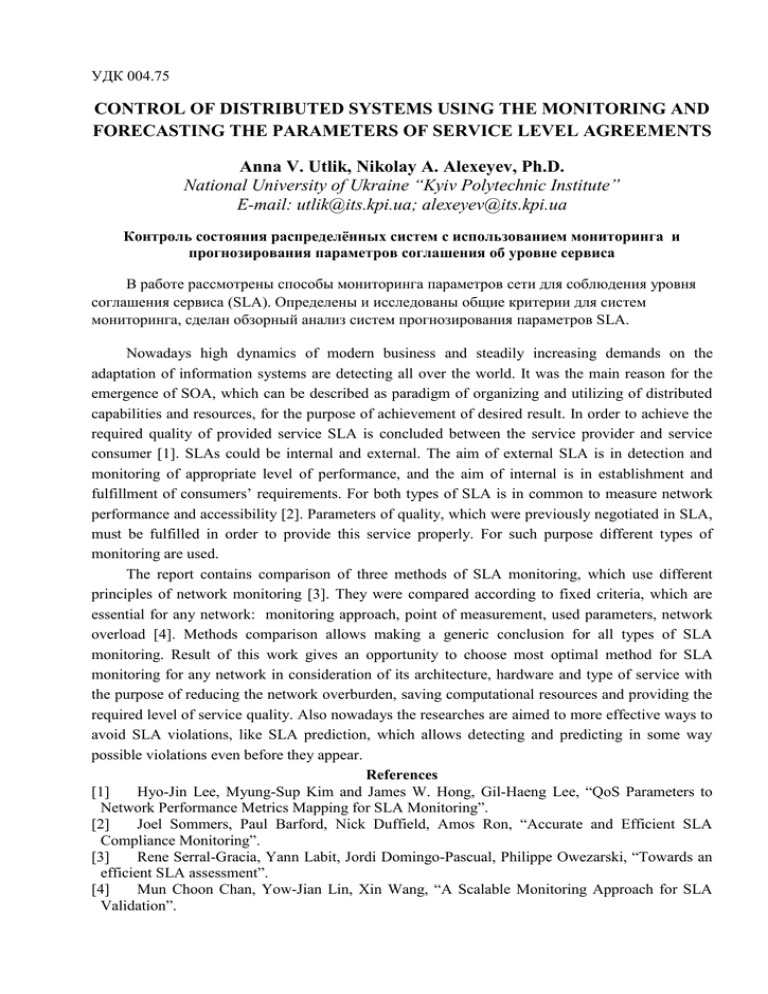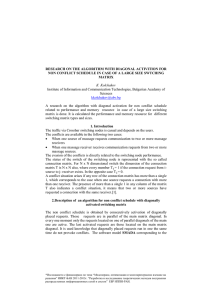нечеткий подход к описанию состояний телекоммуникационой
реклама

УДК 004.75 CONTROL OF DISTRIBUTED SYSTEMS USING THE MONITORING AND FORECASTING THE PARAMETERS OF SERVICE LEVEL AGREEMENTS Anna V. Utlik, Nikolay A. Alexeyev, Ph.D. National University of Ukraine “Kyiv Polytechnic Institute” Е-mail: [email protected]; [email protected] Контроль состояния распределённых систем с использованием мониторинга и прогнозирования параметров соглашения об уровне сервиса В работе рассмотрены способы мониторинга параметров cети для соблюдения уровня соглашения сервиса (SLA). Определены и исследованы общие критерии для систем мониторинга, cделан обзорный анализ систем прогнозирования параметров SLA. Nowadays high dynamics of modern business and steadily increasing demands on the adaptation of information systems are detecting all over the world. It was the main reason for the emergence of SOA, which can be described as paradigm of organizing and utilizing of distributed capabilities and resources, for the purpose of achievement of desired result. In order to achieve the required quality of provided service SLA is concluded between the service provider and service consumer [1]. SLAs could be internal and external. The aim of external SLA is in detection and monitoring of appropriate level of performance, and the aim of internal is in establishment and fulfillment of consumers’ requirements. For both types of SLA is in common to measure network performance and accessibility [2]. Parameters of quality, which were previously negotiated in SLA, must be fulfilled in order to provide this service properly. For such purpose different types of monitoring are used. The report contains comparison of three methods of SLA monitoring, which use different principles of network monitoring [3]. They were compared according to fixed criteria, which are essential for any network: monitoring approach, point of measurement, used parameters, network overload [4]. Methods comparison allows making a generic conclusion for all types of SLA monitoring. Result of this work gives an opportunity to choose most optimal method for SLA monitoring for any network in consideration of its architecture, hardware and type of service with the purpose of reducing the network overburden, saving computational resources and providing the required level of service quality. Also nowadays the researches are aimed to more effective ways to avoid SLA violations, like SLA prediction, which allows detecting and predicting in some way possible violations even before they appear. References [1] Hyo-Jin Lee, Myung-Sup Kim and James W. Hong, Gil-Haeng Lee, “QoS Parameters to Network Performance Metrics Mapping for SLA Monitoring”. [2] Joel Sommers, Paul Barford, Nick Duffield, Amos Ron, “Accurate and Efficient SLA Compliance Monitoring”. [3] Rene Serral-Gracia, Yann Labit, Jordi Domingo-Pascual, Philippe Owezarski, “Towards an efficient SLA assessment”. [4] Mun Choon Chan, Yow-Jian Lin, Xin Wang, “A Scalable Monitoring Approach for SLA Validation”.





